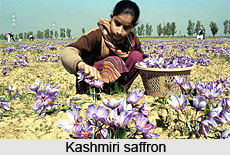Jammu and Kashmir`s economy depends mainly on farming and animal husbandry. Though the manufacturing and services sector is small but it is growing rapidly. Several consumer goods companies have opened manufacturing units in the region. Before insurgency intensified in 1989, tourism formed an important part of the Kashmiri economy. The tourism economy in the Kashmir valley was worst hit. However, Jammu and Ladakh continue to remain as popular tourist destinations, mainly due to its Handicrafts & Textiles. Wood from Kashmir is also used to make high-quality cricket bats, popularly known as Kashmir Willow. Kashmiri saffron is also very famous and brings the state a handsome amount of foreign exchange. Only one S&P CNX 500 conglomerate, the Jammu and Kashmir Bank, has its corporate office in the state. It reported a gross income of 18,394 million INR for 2005.
 Jammu and Kashmir has reaped the benefits of the recent surge in India`s economy. In 2006, the state`s GDP rose to 12 billion USD in current prices. The `new Kashmir`, which the people of Kashmir had adopted as their programme as early as 1944, has been the target of economic development of the state ever since1947.
Jammu and Kashmir has reaped the benefits of the recent surge in India`s economy. In 2006, the state`s GDP rose to 12 billion USD in current prices. The `new Kashmir`, which the people of Kashmir had adopted as their programme as early as 1944, has been the target of economic development of the state ever since1947.
Planning at district and lower levels has been integrated with the programme of the region and the state as a whole and steps taken to remove regional imbalances wherever it has existed. Hence, there has been a progressive increase in the provision of the plan funds under the five-year plans. The objectives of the Eighth Five-year plan for Jammu and Kashmir were self-reliance, increase in productivity, technological upgradation, poverty alleviation and increase in employment strategies. Unfortunately, a major part of the Eighth Five-year plan period was co-terminus with the prevalence of disturbed conditions in the state. Therefore, the desired objectives could not be fully achieved. A major thrust is being given to the infrastructural sectors, such as roads, irrigation and basic minimum services like education, health and water supply, which are in need of considerable augmentation. Power constitutes one of the topmost priorities of the state.




















